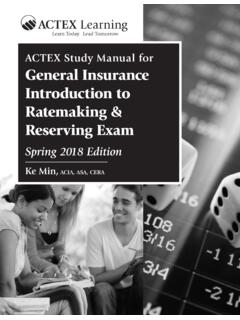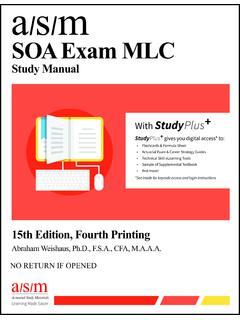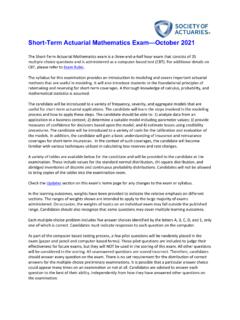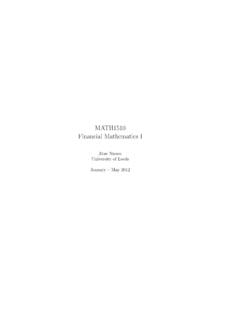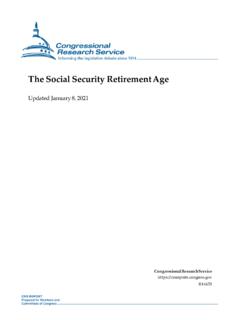Transcription of Section Description 7.3 Asset ... - ACTEX / Mad River
1 Optimal Risky Portfolios Chapter 7 Investments Bodie, Kane and Marcus Exam 9, V1 Page 25 2014 by All 10, Inc. Section Description Introduction Diversification and Portfolio Risk Portfolios of Two Risky Assets Asset Allocation with Stocks, Bonds and Bills The Markowitz Portfolio Selection Model Risk Pooling, Risk Sharing, And Risk of Long Term Investments Introduction This chapter describes how optimal risky portfolios are constructed. Asset allocation and security selection are examined first by using two risky mutual funds: a long-term bond fund and a stock fund. Next, a risk-free Asset is added to the portfolio to determine the optimal Asset allocation. Finally, it will be shown that the best attainable capital allocation line emerges when security selection is introduced. Diversification and Portfolio Risk Investors are exposed to two general types of risk: 1.
2 Market Risk ( systematic risk or non-diversifiable risk). Market risk arises from uncertainty in the general economy associated with conditions such as the business cycle, interest rates, exchange rates, etc. 2. Firm Specific Risk ( non-systematic risk, unique risk, or diversifiable risk). Firm specific risk arises from factors directly attributable to a firm s operations, such as its research and development opportunities or personnel changes. By holding a well diversified set of stocks, investors can significantly reduce their exposure to firm specific risk, but the risk that remains after extensive diversification is Market Risk. These types of risks can be shown graphically as follows: Optimal Risky Portfolios Chapter 7 Investments Bodie, Kane and Marcus Exam 9, V1 Page 26 2014 by All 10, Inc. Portfolios of Two Risky Assets In this Section , we demonstrate how efficient diversification is arrived at by constructing risky portfolios which produce the lowest possible risk for any given level of expected return.
3 Consider a risky portfolio consisting of two risky mutual funds: a bond fund of long-term debt securities, denoted D, and a stock fund, denoted E. Statistics for Two Mutual Funds are as follows: Debt Equity Expected return, E(r) 8% 13% Standard deviation, 12% 20% Covariance, Cov(rD, rE) 72 Correlation coefficient, DE .30 Assume a proportion denoted by wD is invested in the bond fund, and the remainder, (1 - wD) denoted wE, is invested in the stock fund. As was demonstrated in Chapter 6, i. the expected return on the portfolio can be computed as () () ()pDDEEErwErwEr . ii. the variance of the two- Asset portfolio can be computed as 222222(,)PDDEEDED Eww wwCovrr since the covariance can be computed from the correlation coefficient, DE , as ,DEDEDECov r r , the variance can be also computed as 22222 2 PDDEEDEDEDEww ww Notice that although the expected return is unaffected by correlation between returns, portfolios with assets having low or negative correlations reduce the overall portfolio risk.
4 Therefore, portfolios of less than perfectly correlated assets always offer better risk-return opportunities and the lower the correlation between the assets, the greater the gain in efficiency. Optimal Risky Portfolios Chapter 7 Investments Bodie, Kane and Marcus Exam 9, V1 Page 27 2014 by All 10, Inc. Degrees of correlation: When 1 , there is no benefit to diversification. When 1 , the portfolio weights which produce a minimum variance portfolio can be solved using 222,(,)() 2( )EDEMinDEDECov r rwDCov r r . i. In this case, the portfolio weights that solve this minimization problem turn out to be:() .82 MinwD and ( ) 1- .82 = .18 MinwE . ii. Using the data in the table above, this minimum-variance portfolio has a standard deviation of Min = [(.822 122) + (.182 202) + (2 .82 .18 72)]1/2 = When 1 , indicating perfect negative correlation, i.
5 The variance of the portfolio simplifies to 22()PDDEEww ii. a perfectly hedged position can be obtained by choosing the portfolio proportions that solve the equation - 0 DDEEww . The solution to the equation is EDDEw and 1 DEDDEww . These weights drive the standard deviation of the portfolio to zero. Also, it is possible to derive the portfolio variance to zero with perfectly positively correlated assess as well, but this would require short sales. Using the equations above, and varying the weights of the portfolio, the following data can be generated: Portfolio Standard Deviation for given correlations wD wE E(rp) -1 0 .30 1 Minimum Variance Portfolio -1 0.
6 30 WD WE E(rp) p Notes: When 1 , the minimum variance for this portfolio occurs when min20( ;1).625 12 20 EDEwD , and ( ;1) 1 .625 .375 MinwE . Optimal Risky Portfolios Chapter 7 Investments Bodie, Kane and Marcus Exam 9, V1 Page 28 2014 by All 10, Inc. The relationship between expected return and standard deviation, for a given level of correlation between the two funds, is illustrated below. Selection of the optimal portfolio set depends upon the degree of risk aversion (risk-return tradeoffs desired). To summarize, we conclude that: a. the expected return of any portfolio is the weighted average of the Asset expected returns b. benefits from diversification arise when correlation is less than perfectly positive i.
7 The lower the correlation, the greater the potential benefit from diversification. ii. when perfect negative correlation exists, a perfect hedging opportunity exists and a zero-variance portfolio can be constructed. Asset Allocation with Stocks, Bonds and Bills In this Section , two concepts will be demonstrated: 1. Determining the weights associated with the optimal risky portfolio P (consisting of a stock fund and bond fund). 2. Determining the optimal proportion of the complete portfolio (consisting of an investment in the optimal risky Portfolio P and one in a risk free component (T-Bills)) to invest in the risky component. For ease of reference, we restate the characteristics of all securities involved in the complete portfolio: i. Bond Fund: ( ) .08 and .12 DDEr ii. Stock Fund: ( ) .13 and .20 EEEr ,()72 DECov r r and the investor s coefficient of risk aversion, A = 4.
8 Iii. T-Bills: .05fr Optimal Risky Portfolios Chapter 7 Investments Bodie, Kane and Marcus Exam 9, V1 Page 29 2014 by All 10, Inc. Step 1: It can be shown that the weights associated with the optimal risky portfolio P can be determined using the following equations: 222[( ) ] - [( ) ] ( , ) [( ) ] [( ) ] - [( )( ) ] ( , )DfEEfDEDDfEE fDD fE fDEErrErr Covr rwErrErrErr Err Covr r , and 1 - EDww Using the data above, we compute the following: (8 5)400 - (13 5)72 .40(8 5)400 (13 5)144 - (8 5 13 5)72Dw and thus, .60Ew Step 2: Determine the expected return and standard deviation of the optimal risky portfolio: 221/2( )(.4 8) (.6 13) 11% and [(.4144) (.6400) (2 .4 .6 72)] Step 3: Determine the optimal proportion of the complete portfolio to invest in the risky component.
9 Using the following equation, 22().11 - . , the investor would place of his/her wealth in Portfolio P and in T-Bills. Step 4: Determine the percentage of wealth placed in bond and in stocks: .4 * .7439 ,Dyw while the investment in stocks will be .6 * .7439 **A graphical representation of all major concepts considered thus far is shown below** Optimal Risky Portfolios Chapter 7 Investments Bodie, Kane and Marcus Exam 9, V1 Page 30 2014 by All 10, Inc. Recall that C represents the complete portfolio, D represents the bond portfolio, E represents the Equity portfolio, and CAL (P) represents the capital allocation line of the optimal Risky portfolio P. Two noteworthy points: 1. The CAL of the optimal risky portfolio P has a slope of 11- . This exceeds the slope of any portfolio consider thus far, and therefore produces the highest reward to variability ratio.
10 2. The formula for the optimal weights (shown on the prior page) were determined by maximizing the function () - fpppiwErrMax S subject to the constraint that the portfolio weights sum to ( wD+ wE = 1). By doing so, we end up with the weights that result in the risky portfolio with the highest reward-to-variability ratio. The Markowitz Portfolio Selection Model The steps involved in portfolio construction when considering the case of many risky securities and a risk-free Asset can be generalized as follows: Step 1: Identify the risk-return combinations available from the set of risky assets. Step 2: Identify the optimal portfolio of risky assets by finding the portfolio weights that result in the steepest CAL. Step 3: Choose an appropriate complete portfolio by mixing the risk free Asset with the optimal risky portfolio.



